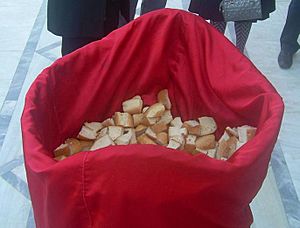Antidoron facts for kids
 |
|
| Type | Blessed Bread |
|---|---|
| Main ingredients | Remains of the loaves of prosphora which were not used for the consecration which is later blessed |
The antidoron (pronounced an-TEE-doh-ron) is a special kind of blessed bread. It's used in some Eastern Orthodox and Eastern Catholic churches. This bread is not the same as the Eucharist, which is the consecrated bread and wine. Instead, antidoron is made from the leftover bread that was prepared for the Eucharist but not used for the main part of the service. The word "antidoron" means "instead of gifts." It's like a special treat given to everyone, even those who don't receive the Eucharist. A similar blessed bread, called pain bénit, is used in some French and Canadian Latin Catholic churches.
Contents
Understanding Antidoron Practice
Antidoron in Eastern Orthodox Churches

In the Orthodox Church, blessed antidoron is given out after every main church service called the Divine Liturgy.
Here's how it works:
- At the start of the service, a priest prepares the bread and wine. This part is called the Prothesis.
- The priest blesses each loaf of bread (called prosphora) as he takes small pieces from it. These pieces are for the Eucharist.
- The rest of the bread is cut into smaller pieces and kept in a bowl. This is the antidoron.
- Towards the end of the service, a helper might give the bowl of antidoron to the priest. The priest then makes the Sign of the Cross over the holy cup (chalice) and plate (diskos).
In the Russian Orthodox tradition, some antidoron is served with regular wine. People who have just received Holy Communion eat it right away.
At the very end of the service, the antidoron is given to people as they come forward to kiss the blessing cross. It's important to remember that antidoron is not a sacrament. It is not the consecrated bread and wine of the Eucharist. Because of this, people who are not Orthodox, and cannot receive the Eucharist, are often invited to take the antidoron. It shows Christian friendship and love.
Some traditions say that antidoron should only be eaten after fasting. Also, it's usually eaten before leaving the church. However, there are some exceptions. For example, many Orthodox churches give antidoron to visitors as a sign of welcome. People might also take a few pieces home for family members who couldn't come to church.
On Bright Saturday, which is the Saturday during Easter week, a special bread called the Paschal Artos is cut up and given out instead of (or in addition to) the usual antidoron.
Antidoron in Eastern Catholic Churches
In some Greek Catholic churches in places like Austria and Hungary, antidoron is given out only a few times a year. This often happens on Bright Saturday. In Greek (Roman) Catholic churches in Italy, it's usually given on Holy Thursday, the Feast of the Assumption, and the feast of Saint Nicolas of Myra. It's also given during some weekday services in Lent. However, in other Eastern Catholic churches, antidoron is given out just like in Orthodox churches.
The History of Antidoron
The idea of giving out blessed bread like antidoron first appeared in Western churches. It was mentioned in a letter by Saint Augustine in the 400s. It was also talked about in church rules from France in the 600s.
Originally, this blessed bread was a comfort for people who couldn't receive Holy Communion. Maybe they hadn't fasted, or they felt they weren't ready. Even if they couldn't take part in the main sacrament, they could still receive this blessed bread. It was a way for them to feel connected to the church service.
In Eastern churches, mentions of antidoron started appearing later, around the 800s and 900s. Many writers from the Eastern Church, like Germanus of Constantinople, wrote about this custom.
Today, the practice of blessing and giving out antidoron continues in Byzantine Rite churches. However, it's rare among Western Christians. It mostly survives as the pain bénit in French churches and cathedrals. You can also find it in some churches in Canada and occasionally in Italy on certain feast days. A similar custom also exists among the Saint Thomas Christians in India.
The Holy Loaf Tradition
Before the English Reformation (a big change in the church in England), there was a tradition called the "holy loaf." Families would take turns baking a loaf of bread and bringing it to their local church. This bread would be blessed and then given out at the end of the church service. Sometimes, the size of the piece people received depended on their social standing. Historian Peter Marshall noted that baking this bread was a special role for local women in the community.
See also
 In Spanish: Antidoron para niños
In Spanish: Antidoron para niños

